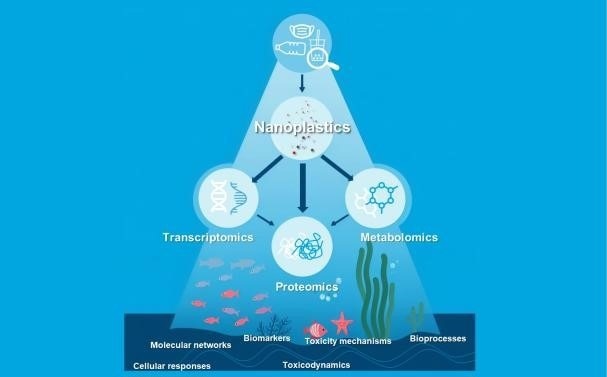Reviewed by Lexie CornerNov 4 2024
An international team of researchers from the University of Southern Denmark and Nanyang Technological University conducted a study using transcriptomics, proteomics, and metabolomics to examine the molecular effects of nanoplastics on aquatic organisms. The study was published in Frontiers of Environmental Science & Engineering.
 Multi-Omics Integration in Nanoplastic Toxicity Analysis. Image Credit: Frontiers of Environmental Science & Engineering
Multi-Omics Integration in Nanoplastic Toxicity Analysis. Image Credit: Frontiers of Environmental Science & Engineering
Plastic pollution is an increasing threat to aquatic ecosystems, with nanoplastics posing unique risks due to their small size and pervasive presence. Unlike larger plastic particles, nanoplastics can enter biological systems and exert complex effects on organisms.
Understanding the toxicity of nanoplastics is essential to developing solutions that protect freshwater and marine species. Detailed investigation into the molecular effects of nanoplastics on aquatic life is key to addressing these challenges.
Researchers assessed molecular responses in various species, uncovering significant cellular disturbances and underscoring the importance of multi-omics approaches in advancing aquatic ecotoxicology.
Results revealed that nanoplastics trigger various harmful responses in aquatic organisms, particularly oxidative stress, metabolic disruptions, and interference with photosynthesis. By integrating data from transcriptomics, proteomics, and metabolomics, researchers were able to trace these effects across biological levels—from stress-induced gene expression to impaired protein synthesis and cellular energy functions.
Importantly, the study identified both common toxicity responses across species and unique chemical reactions in fish, algae, and invertebrates. These findings highlight the need for targeted interventions to address this pervasive issue and underscore the value of multi-omics in detailing the complex effects of nanoplastics on aquatic ecosystems.
Our research sheds light on the complex molecular interactions of nanoplastics within various aquatic species. By integrating multi-omics data, we gain a more detailed view of the toxicity mechanisms, which is critical for evaluating the ecological risks posed by nanoplastic pollution.
Dr. Mohamed Helal, Study Lead Author, University of Southern Denmark
The study's conclusions about the toxicity of nanoplastics have significant ramifications for pollution prevention and environmental policy. By clarifying the chemical impacts of nanoplastics, regulators can create targeted strategies to monitor and reduce plastic pollution in aquatic ecosystems. This research also emphasizes the ongoing need for advancements in omics technologies to support more effective conservation efforts.
The research was funded by the Sapere Aude Research Leader program from the Danish Council for Independent Research. Additional support for KET came from the Research Council of Norway through the projects “In silico and experimental screening platform for characterizing the environmental impact of industry development in the Arctic (EXPECT)” and NIVA’s Computational Toxicology Program.
Journal Reference:
Helal, M., et al. (2024) Multi-omics in nanoplastic research: a spotlight on aquatic life. Frontiers of Environmental Science & Engineering. doi.org/10.1007/s11783-024-1893-3.